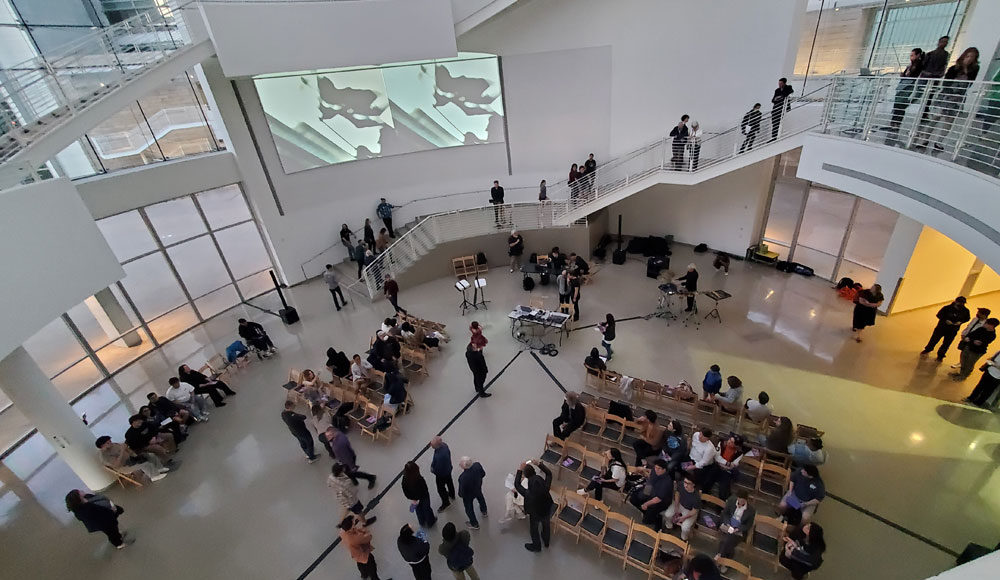Silicon Alleys columnist Gary Singh reviews musical moments created by a collaboration between San Jose State University and the city of San Jose.
The San Jose City Hall Rotunda was never more artfully played than on April 20, thanks to a landmark collaboration between the city government and the faculty of SJSU’s School of Music.
The school premiered two new compositions, Pablo Furman’s “Vortex Shedding and the Bell Ringer’s Call” and Christopher Luna-Mega’s “Diameter Resonant.” Each was written for a mixed ensemble (flute, soprano saxophone, baritone saxophone, percussion and violin) and processed electronic sounds. Each piece took advantage of the rotunda’s architecture and acoustics, while also exploring the spatial and dynamic distribution of performers throughout the building as an alternative to a stage.
For Furman’s piece in particular, the processed electronic sounds were sourced from local streetscape recordings he made while walking from Diridon Station to campus over the course of a year—lightrail trains grinding along the tracks, eerie winds blowing across the Adobe building facades, distant chatter from encampments, or planes flying overhead.
For the gig, the sounds were then used as compositional material, re-orchestrated and diffused through several channels around the Rotunda lobby while instrumentalists including Furman were situated on the floor, the stairs and also on the second floor in a 360-degree layout.
In this way, almost in occult fashion, downtown San Jose’s vibrations, the “harmony of the city” was reimagined in the Rotunda itself via computer technology and the interaction of live acoustic instruments.
After the audience arrived, they were encouraged not to remain in their seats like a traditional concert setting, but instead to wander around the Rotunda for the sound diffusion and venture upstairs where the instrumentalists were strategically placed. In this way, any observer/participant could see and feel just how the composers were indeed “playing the building.”
I cannot stress how much this event demonstrated the cultural evolution of the city government’s relationship with SJSU, compared to 30 years ago.
Now, full disclosure: Beginning in 1990, I was one of Furman’s students. The first undergraduate sound recording class I ever took was his class, which required us to manipulate four-track tape decks, cutting and pasting the magnetic tape, composing sound collages, using the tape decks as instruments, and running our voices through analog flangers and reverb units, while also dreaming of any possible off-campus venue anywhere in San Jose to combine acoustic instruments with electronic sounds live on stage.
At the time, what’s now the City Hall block was a dumpy 99-cent thrift store, a boarded-up dry-cleaner and a liquor store open until 2am. Except for the nearby WORKS Gallery, there were no artsy venues, and no audience for anything outré.
Meanwhile, the city government was awash in failed redevelopment projects and willfully disregarding any role the university might have in downtown’s future. In terms of media, the Mercury News employed old stuffy classical music writers who couldn’t understand anything past 1900, which meant we had to read Metro to learn about anything avant-garde.
As the ’90s unfolded, Macintoshes became powerful enough to handle multitrack recording and eventually digital signal processing, making it much easier to do these types of performances. But there were still no venues, or any way the city government would possibly supply a building of any sort. Such a thing was unimaginable.
As a result, most outré art or music students assumed San Jose and SJSU were doormats, entry-level places on the way to somewhere else, as far away as possible. No one fathomed City Hall moving back downtown or anyone using the building as a musical instrument and sonic sculptural space—the kind of project you’d see in any major European city, but not here.
Now all of this has changed. Faculty or students can wheel a tympani and lug a PA system across San Fernando straight into the Rotunda, as long as they can tolerate the insane bureaucracy of renting the building.
SJSU professor Aaron Lington was among the musicians in the gig. Afterward he had this to say:
“Whenever I start having dark thoughts about the state of music and culture in our society currently, I end up having a night like this where there is sheer unbridled creativity with nearly 200 people in attendance, all enjoying themselves and in awe. Music really is the best.”
He’s right. We’ve come a long way.
Want more Silicon Alleys? Find other columns here.




Good one!